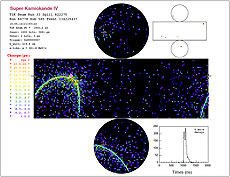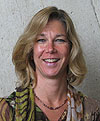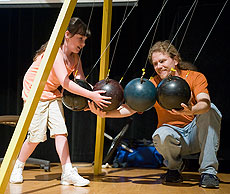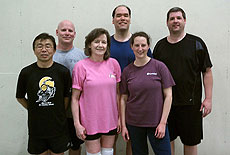|
Have a safe day!
Wednesday, June 15
3:30 p.m.
DIRECTOR'S COFFEE BREAK - 2nd Flr X-Over
4 p.m.
Fermilab Colloquium - One West
Speaker: Jonathan Fortney, University of California, Santa Cruz
Title: The Structural and Thermal Evolution of Transiting Exoplanets:
From Hot Jupiters to Kepler's Super-Earths
Thursday, June 16
2 p.m.
Special Seminar - Curia II
Speaker: John Womersley, UK Science & Technology Facilities Council
Title: Fundamental Physics in the UK and Recent History and
Lessons for the US
2:30 p.m.
Theoretical Physics Seminar - Curia II
Speaker: David Wilson, Argonne National Laboratory
Title: Non-Perturbative Solutions of the Gluon and Ghost
Propagators in Landau Gauge QCD
3:30 p.m.
DIRECTOR'S COFFEE BREAK - 2nd Flr X-Over
4 p.m.
Accelerator Physics and Technology Seminar - One West
Speaker: Yuri Kamyshkov, University of Tennessee
Title: Increasing Yield of Cold and Ultra-Cold Neutrons from
Spallation Target for the Search of Neutron Oscillations
Click here for NALCAL,
a weekly calendar with links to additional information.
Upcoming conferences
|
|
Wednesday, June 15
- Breakfast: English muffin sandwich
- Smart cuisine: Cajun-style lentil soup
- Cajun chicken ranch
- Caribbean jerk pork chops
- Chicken parmesan
- Smoked turkey panini pesto mayo
- Assorted sliced pizza
- Chicken Alfredo fettuccine
Wilson Hall Cafe Menu |
|
Wednesday, June 15
Lunch
- Southern-style chicken salad
- Corn muffins
- Peach pie
Friday, June 17
Dinner
- Romaine, walnut & radish salad
- Veal w/ leek & Roquefort sauce
- Sauté of peas w/ tarragon
- Lemon-scented saffron rice
- White chocolate raspberry terrine
Chez Leon Menu
Call x3524 to make your reservation.
|
|
T2K result indicates electron neutrino appearance

|
| The T2K experiment has detected six candidate events for oscillations of muon neutrinos into electron neutrinos. In this graphic, each colored dot shows the light detected when an electron neutrino hit a water molecule inside the Super-Kamiokande detector and created an electron that led to the emission of Cerenkov light. |
The T2K experiment in Japan has observed six particle events that indicate the oscillation of muon neutrinos into electron neutrinos, a long-sought signal that allows scientists to better understand a phenomenon known as neutrino oscillations. For a long time scientists have suspected that the three known types of neutrinos can morph into each other. Several experiments previously found neutrinos to disappear.
The T2K experiment is the first experiment to report candidate events for the appearance of electron neutrinos in a muon neutrino beam. The experiment analyses a muon neutrino beam that travels 295 kilometers through the earth from the Japan Proton Accelerator Research Complex (J-PARC) to the 50,000-ton Super-Kamiokande neutrino detector.
Based on the analysis of the data collected by the T2K experiment between January 2010 and March 11, 2011, when the experiment was interrupted due to the magnitude 9 earthquake in eastern Japan, scientists found 88 neutrino events that were detected by the Super-Kamiokande detector. Among these 88 events, they identified six candidate events as electron neutrino interactions.
“Congratulations to our Japanese colleagues for their excellent work,” said Fermilab’s Rob Plunkett, co-spokesperson for the MINOS neutrino experiment. “This is a major accomplishment of the T2K program.”
The T2K result indicates that the last unknown neutrino mixing angle, called theta-13, is non-zero, with a significance of 2.5 sigma. If theta-13 were zero, the T2K experiment should only have found one or two electron neutrino events.
The result is good news for the Fermilab neutrino program.
“This is a great result for NOvA,” said Mark Messier, of Indiana University and co-spokesperson of the NOvA neutrino experiment under construction at Fermilab. “It means that NOvA will be able to solve the question of the neutrino mass ordering, a question that no other neutrino experiment in operation or under construction can address. NOvA will let us know whether there are one light and two heavy neutrinos, or whether there are two light neutrinos and a heavy one.”
In addition, a non-zero value of theta-13 opens up the possibility that neutrinos violate the matter-antimatter symmetry and could be the reason that matter dominates over antimatter in our universe, a phenomenon that has puzzled scientists for a long time. The proposed Long-Baseline Neutrino Experiment is designed to look for this effect.
“This is a great time for neutrino physics,” Messier said.
— Kurt Riesselmann

|
| The T2K experiment sends a beam of muon neutrinos from the J-PARC facility 295 kilometers through the earth to the Super-Kamiokande neutrino detector. A near detector measures the purity of the muon neutrino beam, and the Super-K detector looks for the appearance of electron neutrinos due to neutrino oscillations. |
Read the T2K press release
View this story on a separate page.
|
Meet Kathy Burke: New EAP account manager
 |
|
Kathy Burke
|
One of Fermilab’s newest additions is here to help on both sides of the house. Kathy Burke, Fermilab’s new Employee Assistance Program on-site counselor, can provide guidance to managers and a range of counseling services to employees.
Burke is an account manager for Employee Resources Systems, the new contractor to provide EAP services to the laboratory. She will be on site from 8:30 a.m. to 5 p.m. on Wednesdays.
Burke, who has worked with EAP organizations for the past 16 years, has more than 20 years of experience in the field of mental health. She started as a counselor when she joined Employee Resources Systems, and has continued to expand her role within the company.
As the onsite EAP provider for Fermilab, Burke is looking forward to getting to know the laboratory and its employees.
“I’d like to get a better appreciation for the people who work here and the work that they do,” Burke said.
Learning about and helping the Fermilab population will also help ERS get a clearer picture for how things work at the laboratory.
To make an appointment during Burke’s office hours, employees can contact her at x3591. Employees can speak to someone and receive counseling services on other days or after hours 24/7 by calling (800) 292-2780.
Visit the EAP website to search for childcare, eldercare, legal and financial advice and more. The login is "fermilab" and the password is “eap.”
— Rhianna Wisniewski
|
NIU physicist Gerald Blazey accepts two-year post at White House Office of Science and Technology Policy
From Northern Illinois University,
June 14, 2011
DeKalb, Ill. — Gerald Blazey, a Distinguished Research Professor of Physics at Northern Illinois University and special advisor for science to NIU President John Peters, will lend his expertise in the coming years to another president: Barack Obama.
Blazey has accepted a two-year post as a senior policy advisor for the physical sciences in the White House Office of Science and Technology Policy (OSTP). He now reports directly to Carl Wieman, who was confirmed in September by the U.S. Senate to serve as the OSTP Associate Director for Science.
The OSTP provides scientific and technical advice to President Obama and others within the Executive Office of the President and ensures that the scientific and technical work of the Executive Branch is well-coordinated as it relates to both domestic and international affairs.
The physical sciences group at OSTP plays an important role in coordinating interagency relationships between NASA, the National Science Foundation and the Department of Energy and works closely on policy issues relating to particle physics, nuclear physics and materials science, among other topics.
Read more
|
|
CMS luminosity exceeds all expectations
Lothar Bauerdick, head of the CMS Center, wrote this week’s column.
 |
|
Lothar Bauerdick
|
This year's LHC physics run started in March. Since then the machine has broken many records, bringing its luminosity— the number of proton-proton collisions per second— to much higher levels than expected for this year. CMS now can take as much collision data in a single day as it accumulated during all of 2010.
While taking massive amounts of new data, the CMS collaboration continues to publish new results from last year's data set. At the DOE Institutional Review of Fermilab last week, we showed that out of the 51 CMS papers submitted to journals for publications, 14 of these had Fermilab scientists directly involved in the analysis. And our publication list keeps growing.
The LHC team has found ways of continuously increasing the luminosity level. Because of this, we will exceed in the next few days our original luminosity goal of 1 inverse femtobarn of collision data for this run, which ends in October. We expect to get multiples of that data by the end of this run.
The LHC now is running with over 1,000 proton bunches in each beam, and the number of protons per bunch already is approaching the machine design value. Running at such high intensities increases our productivity and scientific output, but it also brings new challenges to the experiment, such as selecting the collision events that need to be recorded and dealing with multiple collisions taking place almost simultaneously in our detector. Typical collision events not only contain overlays of interactions from several proton-proton collisions within two bunches, but also from neighboring bunches. Despite the challenge of reconstructing these very complex events, the software and computing performance continues to be excellent and the data quality remains very high.
Entering a new energy and luminosity regime has been very exciting. Large amounts of new data arrive every week and we analyze and scrutinize them for hints of signals beyond the expected Standard Model of physics. CMS will show its first results with this year's data at the summer conferences, and we expect a rich harvest of exciting physics.
|
DASTOW takes place Wednesday, June 22
 |
| Children learn about physics at the DASTOW 2010 FUNdamentals of Physics show. Photo: Reidar Hahn |
School-aged children will get a chance to see
how education pays off on Wednesday, June 22, when they
visit Fermilab for Daughters and Sons to Work
day.
Fermilab is one of many companies that
honors the event in the summer rather than
have children miss school in April or May
when DASTOW is nationally recognized.
Exposing children to workplaces is one way to
show them the value of education, help them
understand what their parents or relatives do
at work and get them thinking about future
career options. For adults, the day showcases
how employees and employers strive for a
work-life balance.
Fermilab’s DASTOW program returns with
traditional favorite activities including Mr.
Freeze’s cryogenics show, a trip to see the
bison, the
FUNdamentals of Physics show and a demonstration of skills and safety at the Fermilab Fire Department.
The directorate also encourages you to show your child your work area and explain what you do on a daily basis.
For a complete schedule of events and to see
photos from previous DASTOW events, visit
the DASTOW Web page.
To learn more about the history of the national
DASTOW program, started in 1993 as Take
Our Daughters to Work program and
expanded to include boys in 2003, see the
Take Our Daughters And Sons To Work Foundation Web site.
— Tona Kunz
|
Volleyball champs

| The volleyball team "Playing Havoc" won the 2010-2011 season championship of the competitive winter volleyball league. Front row from left: Taka Yasuda, PPD; Sue Grommes, DIR; Michelle Prewitt, Rice University. Back row from left: Rick Jesik, Imperial College; Mark Mattson, Wayne State University; and captain Geoff Savage, PPD. |
|
ES&H weekly report, June 14
This week's safety report, compiled by the Fermilab ES&H section, includes no recordable incidents and two injuries requiring first-aid treatment: An employee received a minor cut when the screwdriver he was using slipped and hit his hand, and an employee suffered a small puncture from a mechanical pencil.
Find the full report here. |
|